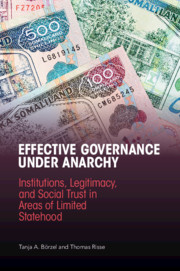 Effective Governance Under Anarchy
Effective Governance Under Anarchy Book contents
- Effective Governance Under Anarchy
- Effective Governance Under Anarchy
- Copyright page
- Contents
- Figures
- Tables
- Preface
- Abbreviations
- 1 Introduction
- Part I Setting the Stage: Concepts and Theories
- Part II Governance in Areas of Limited Statehood: Empirical Evidence
- 4 Who, Why, and How? Actors and Modes of Governance
- 5 Security
- 6 Human Rights, Rule of Law, and Democracy
- 7 Welfare
- 8 Conclusions
- References
- Index
4 - Who, Why, and How? Actors and Modes of Governance
from Part II - Governance in Areas of Limited Statehood: Empirical Evidence
Published online by Cambridge University Press: 09 April 2021
- Effective Governance Under Anarchy
- Effective Governance Under Anarchy
- Copyright page
- Contents
- Figures
- Tables
- Preface
- Abbreviations
- 1 Introduction
- Part I Setting the Stage: Concepts and Theories
- Part II Governance in Areas of Limited Statehood: Empirical Evidence
- 4 Who, Why, and How? Actors and Modes of Governance
- 5 Security
- 6 Human Rights, Rule of Law, and Democracy
- 7 Welfare
- 8 Conclusions
- References
- Index
Summary
Chapter 4 focuses on the variety of governors in areas of limited statehood. State and non-state, local, national, transnational, as well as international actors are motivated to engage in governance in areas of limited statehood if certain conditions are present. Moreover, we find the entire range of modes of governance, from hierarchical steering including the use of force to inclusive, participatory, and deliberative governance. We start with external state governance, including international and regional organizations, development agencies, and foreign governments. We then turn to the non-state sector, starting with (I)NGOs and multi-stakeholder partnerships. A very different type of actor are (multinational) companies who are usually not inclined to become governors to begin with. In contrast, “traditional” authorities, such as tribal chiefs and community leaders as well as non-state justice institutions tend to be among the most important indigenous governors in many areas of limited statehood. A rather unlikely group of governors are violent non-state actors such as rebel groups or warlords.
Keywords
- Type
- Chapter
- Information
- Effective Governance Under AnarchyInstitutions, Legitimacy, and Social Trust in Areas of Limited Statehood, pp. 103 - 144Publisher: Cambridge University PressPrint publication year: 2021


